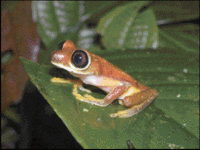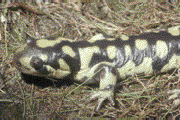Disappearing Jewels: Chapter 2
Contents
- 1 Overview of Distribution and Abundance Table 3. Threat status of amphibians by country and territory. (Source: NatureServe (Disappearing Jewels: Chapter 2) )
- 2 Conservation Status and Imperilment
- 3 Notes This is a chapter from Disappearing Jewels: The Status of New World Amphibians (e-book). Previous: Introduction (Disappearing Jewels: Chapter 2) 2 (Disappearing Jewels: Chapter 2) |Table of Contents (Disappearing Jewels: Chapter 2)|Next: Threats to Amphibians
Overview of Distribution and Abundance Table 3. Threat status of amphibians by country and territory. (Source: NatureServe (Disappearing Jewels: Chapter 2) )
This first-ever compilation of assessments for all New World species indicates that 39%, or two out of every five amphibians are extinct or threatened with extinction (Table 3). Fully 14% of all reliably assessed species (i.e., excluding Data Deficient species) are listed as Critically Endangered, or facing an imminent threat of extinction. With more research, scientists will likely reclassify some of the Data Deficient species to a threatened category. Thus the figure of 39% of New World species being threatened or extinct is probably an underestimate.
A total of 1,057 species falls into the Least Concern category (35%), indicating that they are widespread, common, and have good chances of surviving under current conditions. Many of these species adapt well to human modifications to habitat, or occur in environments that are not immediately threatened by human activities. It is sobering to realize, however, that these secure species are fewer in number than those that are threatened.
A substantial portion of the species, one-fifth of the total, is too poorly known scientifically to be assigned a threat category with confidence (the “Data Deficient” species). The largest numbers of Data Deficient species occur in tropical countries where remote rainforests remain poorly explored by herpetologists. Even the United States has species too poorly known to assess, although this situation is largely a result of recent taxonomic changes.
Status by taxonomic group
 Figure 9. Comparison of major red list categories by taxonomic group. (Source: NatureServe)
Figure 9. Comparison of major red list categories by taxonomic group. (Source: NatureServe) Of the major groups of amphibians, salamanders are slightly more threatened than are frogs and toads (Table 4, Figure 9). Caecilians are so poorly known that over three-fifths of all species fall into the Data Deficient category. With the exception of Typhlonectes compressicauda and Chthonerpeton indistinctum, no one has studied the population trends of caecilians well enough to be able to state that species are increasing or decreasing or deserving of threatened status. Of the taxonomic families that have at least 10 species, the toads (Bufonidae), tropical frogs (Leptodactylidae), mole salamanders (Ambystomatidae), and lungless salamanders (Plethodontidae) are faring the worst, with 45 to 55% of species assessed as threatened. Treefrogs (Hylidae), narrowmouth toads (Microhylidae), and true frogs (Ranidae) have the smallest fraction of threatened species (Table 4). Of special concern are the Darwin’s frogs (family Rhinodermatidae), a Chilean/Argentinean family of which one species (Rhinoderma rufum) has not been seen since 1978 and the other (Rhinoderma darwinii) has declined throughout much of its range. If the trend continues, we will lose an entire family with a unique breeding system (see Introduction (Disappearing Jewels: Chapter 2)).
Extinction
 Table 4. Threat status of New World amphibians by taxonomic group. (Source: NatureServe)
Table 4. Threat status of New World amphibians by taxonomic group. (Source: NatureServe)  Table 5. Extinct amphibians of the New World. (Source: NatureServe)
Table 5. Extinct amphibians of the New World. (Source: NatureServe) Nine New World species are currently classified as extinct, including four frogs, four toads, and one salamander (Table 5). Five of these extinctions have taken place since 1980. The extinct species are all endemic to single countries, including the United States, Honduras, Costa Rica, Venezuela, Ecuador, and Brazil. All of these species had restricted ranges in which extensive searching has failed to turn up any individuals. Several species seen as recently as the 1980s or even the early 1990s, have not been found in more recent surveys. Unfortunately, these nine species may soon have some company. Scientists flagged 117 species as “possibly extinct,” meaning that they are unaware of any extant population but have not performed the extensive searching required to place these species confidently in the Extinct category. In 109 of these cases, the species seem to have disappeared since 1980. Outside of the New World, four species have gone extinct since 1980 and four others are possibly extinct in the same span. In sum, all but eight of the 122 amphibian species worldwide that scientists know or suspect to have gone extinct since 1980 are New World species. Extinctions are therefore a recent, ongoing, and widespread event in amphibians, and concentrated on New World species. Some of these species may turn out to have remnant populations, but further searching could well indicate that many of them are indeed gone.
Comparison to birds and mammals
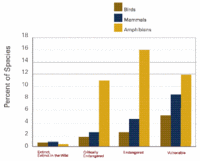 Figure 10. Comparison of status of native new world amphibians, birds, mammals. Bird data from BirdLife International[1]; mammal data from the World Conservation Union[2] and NatureServe[3][4]. (Source: NatureServe)
Figure 10. Comparison of status of native new world amphibians, birds, mammals. Bird data from BirdLife International[1]; mammal data from the World Conservation Union[2] and NatureServe[3][4]. (Source: NatureServe) How do the numbers of threatened species reported here for amphibians compare to those for other kinds of animals? After all, environmentalists have been sounding the extinction alarm for decades now. Are amphibians any worse off than other groups?
The only other groups available for accurate comparison are the birds and mammals. No other animal or plant group has been exhaustively assessed for IUCN status for the entire New World. This comparison shows that a far greater percentage of New World amphibians fall into each of the Red List threat categories than do species of either birds or mammals from the region (Figure 10). Amphibians are five to seven times more likely to be Critically Endangered, three to six times more likely to be Endangered, and about twice as likely to be Vulnerable as are birds or mammals. Conversely, only 61% of amphibians fall into one of the unthreatened or data deficient categories, as opposed to 84% of mammals and 90% of birds. Overall, 10% of New World birds and 16% of New World mammals are threatened, contrasting with 39% of all New World amphibians. Clearly, amphibians face risks far in excess of those experienced by other well-studied groups.
Regional Status
 Figure 11. Comparison of major red list categories for amphibians by region. (Source: NatureServe)
Figure 11. Comparison of major red list categories for amphibians by region. (Source: NatureServe) Threat levels affecting amphibians vary widely among [[region]s] (Figure 11). In the Caribbean, where most species have small geographic ranges within single islands and habitat destruction is rampant, four-fifths of all species are threatened. On the other end of the spectrum is North America, where “only” one-quarter of the species are threatened. Half of Mesoamerican species are threatened, as are nearly a third of South American species. Scientific knowledge is best for Caribbean species, none of which fell in the Data Deficient category. The biggest challenge for scientists is South America, where a quarter of all species (532 in total) are too poorly known to classify.
South America
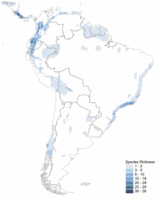 Figure 12. Distribution of threatened amphibians in South America. (Source: NatureServe)
Figure 12. Distribution of threatened amphibians in South America. (Source: NatureServe) While threatened species occur in every South American country, they cluster in two distinct areas (Figure 12). The first includes the Cordilleras Occidental and Central in the Colombian Andes, continuing south into Ecuador on the Cordilleras Occidental and Oriental (see Box 6). The second is in the central Atlantic Forest of Brazil along the Serra do Mar, centered on Rio de Janeiro and southeastern São Paulo (see Box 7). The Andes are considerably steeper and higher in elevation, but concentrations of threatened species are similar in the two areas. The most secure faunas occur in the Orinoco and Amazon River drainages, the caatinga-cerrado-Pantanal region of central and northeastern Brazil, the Gran Chaco of Bolivia, Paraguay, and Argentina, and the Pampean and Patagonian regions of Argentina.
Mesoamerica
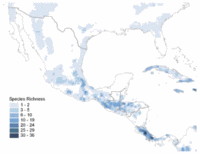 Figure 13. Distribution of threatened amphibians in Mesoamerica. (Source: NatureServe)
Figure 13. Distribution of threatened amphibians in Mesoamerica. (Source: NatureServe) Mesoamerica has multiple centers of threatened species (Figure 13). The greatest concentrations occur in the Chiriquí highlands of western Panama and the Cordillera Volcánica Central of Costa Rica. Many threatened amphibians also exist in the Cordilleras de Talamanca and Tilarán in Costa Rica; the northern and western highlands of Honduras; the Guatemalan highlands; and eastern Chiapas, central Oaxaca, and the eastern portion of the Central Volcanic Belt in Puebla and Veracruz, Mexico. Areas with few threatened species can be found in both mountainous (Chihuahua, Mexico) as well as lowland areas (Yucatán Peninsula-northern Belize, Honduran and Nicaraguan Mosquitia, and lowland coastal Panama).
Caribbean
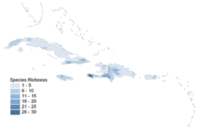 Figure 14. Distribution of threatened amphibians in Caribbean. (Source: NatureServe)
Figure 14. Distribution of threatened amphibians in Caribbean. (Source: NatureServe) As in Mesoamerica, concentrations of threatened species are spread widely in the Caribbean (Figure 14). Each of the Greater Antilles supports at least one center of threatened species. On Cuba, these areas are in the Sierra de los Órganos in the west and the Sierra Maestra in the east. On Jamaica, threatened species are concentrated in the Cockpit Country in the western interior. On Hispaniola, which is divided into the countries of Haiti and the Dominican Republic, critical areas are the Cordillera Central and Tiburon Peninsula. And on Puerto Rico, threatened species cluster in the Cordillera Central.
North America
 Figure 12. Distribution of threatened amphibians in North America. (Source: NatureServe)
Figure 12. Distribution of threatened amphibians in North America. (Source: NatureServe) North America has by far the most secure amphibian fauna of the New World. There are no concentrations of threatened species of the same scale as those found in the rest of the hemisphere (Figure 15). Instead, threatened species are scattered in coastal and southern [[region]s] from the Pacific Northwest to southern California and eastward through southeastern Arizona, southwestern New Mexico, and Texas, to southern South Carolina. Additional threatened species occur in the Great Smoky Mountains. In the rest of the continent, many species are declining locally, such as the western toad (Bufo boreas) in the western United States, but no species is threatened with global extinction. Only one threatened species, the Oregon spotted frog (Rana pretiosa), occurs as far north as Canada.
Status by country
New World countries span the gamut from those that harbor virtually no threatened species (e.g., Paraguay, Suriname, and Canada) to countries in which nearly every native species is threatened (e.g., Haiti, Dominican Republic) (Figure 16). The nations with the greatest fraction of their faunas threatened are all in the Caribbean—island nations home to species with very small ranges. If the population of a restricted range species is decreasing even moderately, Red List criteria place it in one of the “threatened” categories. Widespread tourist development, conversion of habitat to agricultural uses, and the consequences of human poverty (in some places) have caused the populations of numerous frogs to decline in the Caribbean.
On the mainland, countries in the temperate zones (e.g. U.S., Canada, Argentina, Uruguay) or those dominated by lowlands where species tend to have broad distributions (e.g. Belize, Guyana) have much more secure faunas. Mountainous tropical countries tend to harbor many species with small ranges that are much more sensitive to habitat destruction. These countries therefore have a higher portion of their fauna with threatened status (e.g. Mexico, Guatemala, Ecuador).
The fact that a nation has a significant portion of its species in threatened categories does not necessarily reflect on its biodiversity protection efforts. In Costa Rica, for example, despite an extensive system of protected areas in its highlands, 35% of the species are threatened. There amphibians have been devastated in montane areas even within parks, probably due to disease, climate change, or a combination of both factors. In Uruguay, conversely, just 4 of 43 species are threatened, but the country has no system of national parks or protected areas. Most of Uruguay’s species are widespread, occurring in Argentina and Brazil as well, where they find some legal habitat protection.
Ecological factors
 Figure 17. Proportion of threatened species by elevation. Many species occur in more than one elevational band. Data deficient species not included. (Source: NatureServe)
Figure 17. Proportion of threatened species by elevation. Many species occur in more than one elevational band. Data deficient species not included. (Source: NatureServe)  Figure 18. Proportion of threatened species by size of species range. Many species occur in more than one elevational band. Data deficient species not included. (Source: NatureServe)
Figure 18. Proportion of threatened species by size of species range. Many species occur in more than one elevational band. Data deficient species not included. (Source: NatureServe) Amphibians vary considerably in the [[habitat]s] they occupy, the elevations where they occur, and their distributional extent. How do these factors correlate with threat status? First, threatened species are more likely than non-threatened species to be entirely terrestrial (47% versus 28%, respectively), and less likely to occur in both terrestrial and aquatic habitats during different life stages (50% versus 71%). Few species are entirely aquatic (4% of threatened and 2% of non-threatened species). The pattern is somewhat complicated because species that are Critically Endangered are more likely to have an aquatic phase of their life cycle than other threatened species. Second, higher-elevation faunas are much more threatened than lower-elevation faunas (Figure 17). Finally, species with smaller distributional ranges are much more likely to be threatened than species with larger ranges (Figure 18), a result that is not surprising considering that small range size is part of the Red List criteria. This analysis leaves us with a picture of terrestrial, montane, range-restricted species typically being most threatened while lowland species that occur in both aquatic and terrestrial habitats over large areas are the least likely to be threatened.
Conservation Status and Imperilment
|
Table 1. Overall Amphibian Diversity-Top Ten New World CountriesCountry No. of SpeciesBrazil 731Columbia 698Ecuador 447Peru 398Mexico 351Venezuela 293United States 262Bolivia 201Panama 189Costa Rica 1Many amphibian (Disappearing Jewels: Chapter 2) families are restricted to the New World. Half of the world’s salamander families (Ambystomatidae, Amphiumidae, Dicamptodontidae, Rhyacotritonidae, and Sirenidae) occur here and nowhere else. One caecilian family (Rhinatrematidae) and nine frog families (Allophrynidae, Ascaphidae, Brachycephalidae, Centrolenidae, Dendrobatidae, Leptodactylidae, Rhinodermatidae, Rhinophrynidae, and Scaphiopodidae) are similarly restricted to the New World. With 1,124 species in North, Central, and South America as well as the Caribbean, the Leptodactylidae is the most species-rich family of amphibians on Earth. Patterns of amphibian diversity (Species diversity) are a result of the complex interactions of several variables: geological history, topography, current environmental conditions, and competition among species themselves. Salamanders are most diverse in the southeastern United States and Mesoamerica (see Box 4). Frogs and toads are most diverse in the upper Amazon Basin and eastern Brazil. The less numerous caecilians are most diverse in the Amazon basin (Figures 2-4). What follows is a brief south to north overview of amphibian diversity in the major [[region]s] of this hemisphere, home to 3,046 species, over half (53%) of the world’s known amphibians. Tables 2 and 3 show summary data for the hemisphere. A complete species list is available online[5]. 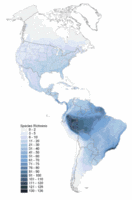 Figure 2. Diversity of New World frogs and toads. (Source: NatureServe) Figure 2. Diversity of New World frogs and toads. (Source: NatureServe) 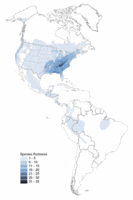 Figure 3. Diversity of New World salamanders. (Source: NatureServe) Figure 3. Diversity of New World salamanders. (Source: NatureServe) 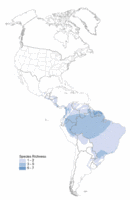 Figure 4. Diversity of New World caecilians. (Source: NatureServe) Figure 4. Diversity of New World caecilians. (Source: NatureServe) South AmericaIn terms of amphibian diversity (Species diversity), South America is second to none. An astonishing 2,065 species occur within its continental landmass, more than anywhere else on Earth. And this total is far from complete. Taxonomists are discovering and naming new species faster today than ever before[6]. By contrast, birds were mostly discovered and named in the nineteenth century, with just a trickle of new species still being found today. South America owes its diversity to geological history, extensive moist areas, diversity of [[habitat]s], and its current fortuitous position straddling the equator. The major groups of amphibians had dispersed into South America before it separated from other Southern Hemisphere continents 30 to 35 million years ago[7]. The Andes, one of the largest mountain ranges on earth, began to uplift 70-80 million years ago as South America drifted west from Africa[8]. The rugged slopes of this 7,500-kilometer-long cordillera created numerous barriers to amphibian dispersal, fostering speciation as populations developed in local isolation. The topographical relief of the other major mountain ranges, the ancient Guianan tepuis and the highlands of eastern Brazil, also provided numerous opportunities for speciation. Finally, the climatic effects of cold ocean currents interacting with these mountain ranges has led to complex patterns of wet and dry habitats on the continent. 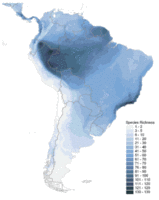 Figure 5. Amphibian diversity in South America. (Source: NatureServe) Figure 5. Amphibian diversity in South America. (Source: NatureServe) Amphibians, with their dependence on water (or at least humid microhabitats) and avoidance of temperature extremes, are more abundant in mild, wet climates. Montane species tend to have small distributional ranges whereas lowland species, with less severe barriers to dispersal, tend to be broadly distributed. Not surprisingly, amphibian diversity (Species diversity) is highest in moist tropical highlands and lowest in dry temperate lowlands of southeastern Bolivia south through Argentina (Figure 5). The highest diversity of amphibians occurs in the upper Amazon basin and in the Atlantic Forest of eastern Brazil. The narrow ranges of some Andean and (to a lesser degree) Atlantic Forest species are remarkable. Numerous species are restricted to single watersheds; some are still only known from the site where scientists first spotted them. The salamanders of South America are conspicuous by their rarity, with just 28 species in two genera occurring here. Ancestors of these species appear to have dispersed from North America into a previously salamander-free South America during the last three to five million years since the Isthmus of Panama formed. Caecilians, though inconspicuous, are in fact fairly diverse in South America, where varied [[habitat]s] support fully half of the Earth’s species. But the real show in South America is the frogs and toads, responsible for 95% of the continent’s amphibian fauna (1,959 species). These creatures live in nearly every conceivable habitat. For example, the toad Bufo atacamensis occurs in oases in the middle of Chile’s Atacama Desert, the driest place on Earth. The frog Telmatobius marmoratus occurs in streams at up to 5,000 meters elevation, high above the tree line in the Andes. The family Leptodactylidae has diversified into 834 species, including 421 species in the genus Eleutherodactylus, the world’s most diverse vertebrate genus. Many more leptodactylid species have dispersed to and diversified in the Caribbean and Mesoamerica, even reaching the southern United States. South America is the only place you can find the Tukeit-Hill frog (Allophryne ruthveni), a frog so different from all others that it was placed in its own family (Allophrynidae). Other unique South American families include the gold frogs (Brachycephalidae), a group of six minute, often brightly colored species, and the two species of Darwin’s frogs (Rhinodermatidae). When it comes to frog diversity (Species diversity), nature’s imagination goes far beyond the homogeneous green creatures of television animations or the stuffed toys that accumulate in our children’s bedrooms. In South America, these animals are remarkably variable in size, shape, color, and pattern. Poison dart frogs (family Dendrobatidae), named for a species in Colombia that was used by indigenous peoples to anoint hunting darts, can have blotches on their skin of every color in the rainbow. These tiny gems can be very common along tropical streams and on the forest floor. Monkey treefrogs in the genus Phyllomedusa wear Cheshire-cat smiles that never go away. Harlequin toads (genus Atelopus) display every conceivable pattern of black and yellow, with a little red or orange thrown in on occasion for variety. South America indeed hosts an astonishing assemblage of frogs with forms and colors that seemingly could exist only in an artist’s imagination. MesoamericaConsidering that the land mass of Mesoamerica is dwarfed by neighboring continents to the north and south, amphibian diversity in the region—685 species—is extraordinary. Like South America, Mesoamerica owes its diversity to complex topographical relief and consequent variety of [[habitat]s], moist climate regimes, and location in the tropics. In addition, Mesoamerican diversity (Species diversity) has benefited from dispersal into the region from both North and South America. The geological history of Mesoamerica is far too complex and controversial to describe in detail here. Briefly, the land north of the Isthmus of Tehuantepec (the narrow constriction in Mexico in Veracruz and Oaxaca states) is historically part of the North American continent. The land south of the Isthmus to the southern Nicaragua lowlands is a mosaic of plates that have rearranged themselves and alternately been submerged and exposed by the ocean several times during the last 65 million years. The region encompassed by Panama, Costa Rica, and southern Nicaragua formed over the last three to ten million years through a combination of volcanic activity and uplift[9]. The result is a jumble of mountain ranges interrupted by valleys and lowlands. Like South America, humid mountain slopes rise above both dry (generally on the Pacific side) and wet (Caribbean side) lowland habitats. 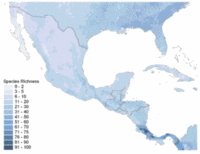 Figure 6. Amphibian diversity in Mesomerica. (Source: NatureServe) Figure 6. Amphibian diversity in Mesomerica. (Source: NatureServe) The presence of moist tropical highlands has again led to extensive diversification of amphibian forms. Unlike in South America, salamander diversification here is substantial, with 213 salamander species known. South of central Mexico, all salamanders belong to the family Plethodontidae (the lungless salamanders), a group that is also widespread in North America. This observation suggests that salamanders dispersed into Mesoamerica from the north. Salamander diversity (Species diversity) is concentrated in the highland areas of southern Mexico and Guatemala. Diversity is highest in cool, humid, montane forests and lowest in dry lowlands. In fact, the salamander Pseudoeurycea gadovii occurs at elevations as high as 5,000 meters on the upper slopes of the Pico de Orizaba volcano, the highest point in Mexico. The highest elevation recorded in Mesoamerica for a frog, by contrast, is just 3,600 meters for the ridged treefrog (Hyla plicata) in central Mexico. Frogs and toads have also diversified into myriad species in Mesoamerica. The taxonomic affinities clearly indicate that the ancestors of these species dispersed into Mesoamerica from both the south and north. For example, the frog genus Rana has 26 members in the United States, dwindling southward to four species in Panama. The poison dart frogs (family Dendrobatidae), glass frogs (family Centrolenidae), and harlequin toads (genus Atelopus) are groups that have dispersed in the other direction from South America. Although no families are endemic to Mesoamerica, several genera (e.g., Anotheca, Atelophryniscus, Bradytriton, Chiropterotriton, Crepidophryne, Cryptotriton, Dendrotriton, Duellmanohyla, Ixalotriton, Lineatriton, Nototriton, Nyctanolis, Oedipina, Parvimolge, Plectrohyla, Ptychohyla, Thorius, and Triprion) appear to have originated in Mexico, the [[mountain]s] of Guatemala and Honduras, and the Cordillera de Talamanca in Costa Rica and Panama. In most cases, the species in these genera are restricted to highlands. The highest concentrations of frog and toad species occur in the Caribbean lowlands of Costa Rica and Panama and the Pacific lowlands of southern Costa Rica and Panama (Figure 6). There we find remarkable numbers of species. For example, La Selva Biological Station, a 1,600-hectare mixture of old growth and second-growth forest in the Caribbean lowlands of Costa Rica, has 44 species of frogs and toads[10]. Farther south, this number increases to 59 species in the slightly larger area of Soberanía National Park along the Panama Canal[11]. The origin of much of this diversity (Species diversity) is the closing of the Isthmus of Panama, which allowed South American species to spread northward and give rise to new forms. Unlike salamanders, frog and toad diversity does not increase appreciably with elevation. Above 1,600 meters elevation, diversity drops steadily. Scientists have identified 16 species of caecilians in Mesoamerica, ranging as far north as southern Mexico. With so few species (that have likely colonized from South America since the closure of the isthmus in Panama) it is inappropriate to talk of “hot spots” of diversity. In our current state of knowledge, Panama is home to ten caecilian species, Costa Rica has seven, and no other country has more than two species. Caecilians are creatures of the lowland moist forests, rarely occurring as high as 1,400 meters elevation. All species in the region are terrestrial. CaribbeanLike Mesoamerica, the Caribbean islands are located midway between North and South America. But because amphibians, with no ability to swim in salt water or fly, have such a hard time dispersing to the islands, we find very different patterns of amphibian diversity (Species diversity) in the Caribbean. The most striking difference is that no salamanders or caecilians occur on any of the islands. The other obvious contrast with Mesoamerica is that few genera or families of amphibians occur in the Caribbean. Whereas there are 15 families and 67 genera in Mesoamerica, just four families and five genera occur in the Caribbean. The vast majority (88%) of the Caribbean’s 171 amphibian species belong to just one genus of frog, Eleutherodactylus. 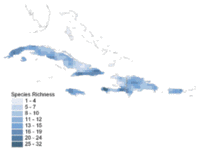 Figure 7. Amphibian diversity in Caribbean. (Source: NatureServe) Figure 7. Amphibian diversity in Caribbean. (Source: NatureServe) The geological history of the Caribbean can explain some of these patterns. Although the subject remains under intense study, most geologists agree that the Greater Antilles (Cuba, Jamaica, Hispaniola, and Puerto Rico) are geological cousins of the plates that make up northern Central America. When dinosaurs still rumbled across the landscape, these islands were lined up more or less between North and South America in approximately the location of present day Central America. Over the last 70 million years, these islands have drifted east to their current positions. The trailing edge of this parade of islands has fused to North America and now makes up northern Central America. Some of the Greater Antilles may have had temporary land connections with North and/or South America as they drifted eastward[12]. 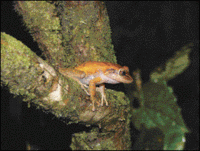 Common coqui (Eleutherodactylus coqui). Near Threatened. Puerto Rico. Amphibians disperse from the mainland to Caribbean islands with difficulty, then evolve there in isolation. The Caribbean islands are home to 171 species of frogs and toads, but not a single species of salamander or caecilian. (Photo by Forrest Brem) Common coqui (Eleutherodactylus coqui). Near Threatened. Puerto Rico. Amphibians disperse from the mainland to Caribbean islands with difficulty, then evolve there in isolation. The Caribbean islands are home to 171 species of frogs and toads, but not a single species of salamander or caecilian. (Photo by Forrest Brem) The Lesser Antilles formed in a completely different manner. As the Caribbean Plate was pushing the Greater Antilles northward and eastward, it ran up on top of the oceanic Atlantic Plate. Periods of [[volcanic] activity] along the arc of this collision zone created the many small islands known collectively as the Lesser Antilles, which today include such idyllic tourist destinations as the Virgin Islands and Barbados[13]. How did amphibians get onto these islands? Two scenarios seem plausible. First, some ancestral amphibians may have hopped onto the islands of the Greater Antilles long ago when they had temporary land connections with North or South America[14]. However, the presence throughout much of the islands of limestone—a rock that only forms under salt water—suggests that they were submerged 30 million years ago. Any frogs present at that time would have met certain extinction. The second, more likely origin of amphibians in the Caribbean is the dispersal of animals via rafting. During violent storms, large tangled masses of trees and other vegetation can float out to sea and be carried to distant shores on ocean currents. In rare cases, frogs and toads can survive on these natural rafts to colonize islands. Once established, frogs disperse across the island and, through the age-old process of natural selection, diversify and adapt to local [[habitat]s] over the course of millions of years. Ocean currents in the Caribbean flow generally from south to north, so it is not surprising that most Caribbean amphibians are more closely related to those in South America than elsewhere. The few genera in the Caribbean suggest that the fauna we see today is derived from very few colonization events[15]. We therefore have a fauna that was founded by a very few amphibian colonists, which then diversified in their new homes (see Box 5). Virtually all Caribbean amphibians (94%) are endemic to single islands, indicating that dispersal events between islands are rare. Species have diversified to occur on high mountain ranges such as the Cordillera Central in the Dominican Republic and sea-level mangrove swamps in Haiti. The highest densities of species occur in moist mountain ranges, such as the Sierra Maestra and Macizo de Sagua- Baracoa in eastern Cuba, the Cockpit Country of western Jamaica, the Massif de la Hotte in Haiti, the Massif de la Selle / Sierra de Baoruco on the Haitian-Dominican Republic border, and El Yunque in Puerto Rico (Figure 7). Species diversity is low on the islands of the Lesser Antilles, a consequence of their small land area and their isolation from potential founding populations. North AmericaAlthough North America, with its 262 species, does not have the megadiversity of neighboring tropical [[region]s], the continent’s amphibian fauna is nevertheless impressive. Take the tiger salamander (Ambystoma tigrinum), for example. This adaptable species can be found in the western portion of its range from sea level all the way up to 3,660 meters elevation. Few tropical salamanders span more than 1,200 meters of elevation and none come close to the tiger salamander’s adaptability. Distributions of many North American species are enormous compared with their more southerly cousins. For example, the wood frog, our arctic hero, has a cross-continental range that abuts the shores of three oceans—Atlantic, Pacific, and Arctic. 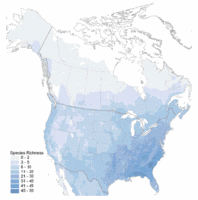 Figure 8. Amphibian diversity in North America. (Source: NatureServe) Figure 8. Amphibian diversity in North America. (Source: NatureServe) Other noteworthy North American amphibians include the hellbender (Cryptobranchus alleganiensis) and the unique eel-like sirens and amphiumas that are nearly restricted to the southeastern United States. Some of these thoroughly aquatic salamanders reach lengths of 75 to 100 centimeters or more, placing them among the New World’s largest amphibians. North America also hosts a diverse group of cave-adapted salamanders. Some of these species, which are typically endemic to single cave systems, have greatly reduced eyes that may be rather useless in the eternal darkness of their [[habitat]s]. Also worthy of mention are the two species of tailed frogs (genus Ascaphus), the only frogs that sport a tail-like appendage when fully adult. North America currently has a land connection only to South America, but that was not always the case. Over the past 60 million years, North America has also had land connections with both Asia and Europe[16]. This observation may explain why members of the salamander family Cryptobranchidae (including the hellbender) occur only in eastern Asia and North America, and how a few species of the Plethodontidae, a family of salamanders restricted primarily to the New World, arrived in Europe. The Appalachian Mountains began to uplift before the first amphibian crawled or hopped, and have been gradually eroding ever since. The moist temperate forests that cover these [[mountain]s] today grow on severely eroded remnants of a formerly towering cordillera. These mountains, especially their southern extreme, are home today to the most diverse salamander fauna in the world (see Box 4). Although North American salamander diversity (Species diversity) peaks in the Southern Appalachians, frog and toad diversity peaks on the coastal plain that slopes gradually from these mountains to the Atlantic Ocean and Gulf of Mexico. There a visit to a pond in good habitat on a warm, drizzly spring night can yield over a dozen species of amphibians, including treefrogs, spadefoots, cricket frogs, chorus frogs, true frogs, and toads. Most males will be squawking, beeping, and trilling away, while a fortunate few will cling to females about to lay eggs. Another concentration of North American amphibian diversity occurs in the Pacific states of California, Oregon, and Washington (Figure 8). This region is home to a variety of giant, mole, and lungless salamanders, as well as true frogs and toads. Some of these animals, such as the mountain yellow-legged frog (Rana muscosa), breed in alpine lakes at elevations up to 3,600 meters in the Sierra Nevada. The soggy rainforests of the Pacific Northwest provide good habitats for salamanders. Many species, such as the Pacific giant salamander (Dicamptodon tenebrosus, one of the largest terrestrial salamanders on Earth), occur in damp mats of moss or under rotting tree trunks. Others, such as the Olympic torrent salamander (Rhyacotriton olympicus), inhabit cold springs and streams in old growth forests. By contrast, the extensive arid regions of most of western North America hold few amphibians, although interesting drought-adapted species have evolved in these habitats. Notes This is a chapter from Disappearing Jewels: The Status of New World Amphibians (e-book). Previous: Introduction (Disappearing Jewels: Chapter 2) 2 (Disappearing Jewels: Chapter 2) |Table of Contents (Disappearing Jewels: Chapter 2)|Next: Threats to Amphibians
|

